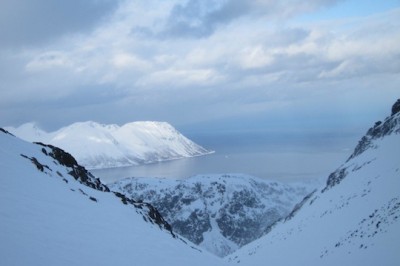A major avalanche that killed five Swiss and French ski tourists in northern Norway on Monday is being blamed mostly on the skiers themselves. Local authorities and mountaineers claim they didn’t use a local guide and ventured into a dangerous area where avalanche danger was extremely high.

Norwegian media outlets were full of reports on Tuesday that the skiers set off the avalanche that crashed down the steep sides of the mountain known as Sorbmegaisa, which in the local Sami language translates as a mountain where accidents are likely. One skier from Switzerland was dug out alive from the snow and rushed to hospital in Tromsø, but another five in the group were found dead.
The mountain and surrounding peaks in the area are highly popular for adventuresome, expert skiers and even have won praise from Norway’s own Crown Prince Haakon, who has skied there himself. Off-piste skiing is common, with skiers often arriving by boat from across the fjord. Then they head up the mountain on foot, either on skis or carrying them, before skiing back down.
The website for the local Lyngen Lodge (external link) at nearby Djupvik, just north of the 1,288-meter-high Sorbmegaisa, describes the mountain as offering “huge potential for freeriding with many high quality mountain lines to choose from. The descents are long and angle perfect in powder …” It also cautions, though, that strong winds can build “slab avalanche risk on the sides of the big bowls” of the mountain.
‘Difficult terrain’
The acting mayor of the local municipality of Kåfjord, Svein O Leiros, told reporters that he and others have long feared deadly accidents because of the avalanche danger in the high peaks around the area. “But we have no laws or regulations that can prevent folks from heading out into the nature,” Leiros told newspaper Aftenposten.
“We recommend that everyone use local guides, but there are many who don’t want to pay for that,” Leiros said. “The terrain is difficult, and tourists can also expose search and rescue crews to danger in the case of accidents.” Around 40 persons participated in Monday’s emergency operation.
Leiros said local experts believed the skiers, all of whom were equipped with devices meant to signal their location in the event of avalanche, set it off themselves by moving into an area with mountainsides as steep as 45-60 degrees. The group of six caught in the avalanche were not using a local guide, according to Aftenposten.
“The (doomed) skiers set off the avalanche when they skied into the area,” Graham Austick of Lyngen Lodge told Aftenposten. “I can say that on the basis of several aspects, like which way the ski trails went, the steep terrain with a 42-degree slope, the weather conditions and the snow layers.” Austick, reported Aftenposten, is educated as an avalanche expert in Austria and has been in Kåfjord since 2008.
Austick said the lodge provided no guided tour to the group, only rescue logistical support on Monday, alongside police and Red Cross services.
Debate over warning system
Norwegian Broadcasting (NRK) aired debate Tuesday morning on whether there were adequate warnings posted of the avalanche danger, and whether more signs should be posted in popular skiing areas. Environmental activists called it unrealistic to set up more signs, and claimed both locals and tourists need to take responsibility for checking out local conditions themselves.
The weather in the area on Monday was described as fine, with sunny skies and temperatures just below the freezing point. Lyngen Lodge itself had raved about “another week of skiing in sunshine” on its own website, publishing spectacular photos and reporting fresh snow and sunshine (external link) on March 18, but also noting a “windy ridge” and the need for “avalanche snow safety training” along with “some great skiing on Storhaugen and Uløya.” As late as last week, on March 14, the skiing on both Storhaugen and Sorbmegaisa was described as “sensational.”
Elling Vatne, leader of the Kåfjord Red Cross, said conditions in the area had been difficult all winter, first because of frost and ice followed by heavy snow. “Then it doesn’t take much to have an avalanche,” Vatne told Aftenposten.
Views and News from Norway/Nina Berglund
Please support our stories by clicking on the “Donate” button now:

